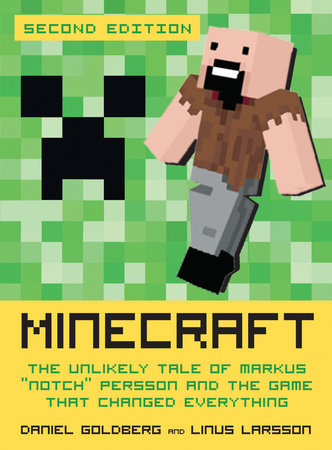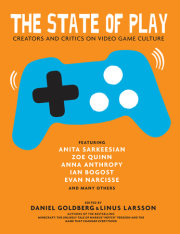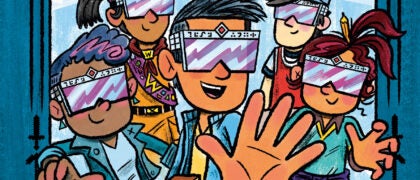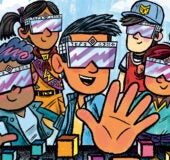Chapter 1
Three, Two, One . . .
It’s November 18, 2011. An old man in a faded gray
sweater looks up from his slot machine. A long and
steady stream of children, teens, and grown-ups flows
through the casino. Their outfits are odd, even for this
place. In Las Vegas, you can count on seeing pretty much
anything: Elvis impersonators lined up on the sidewalks,
gigantic fake-gold lions, drunken weekend revelers, and
fountains shooting water hundreds of yards into the air
synchronized to the tune of the national anthem.
The people streaming through the casino at the Hotel
Mandalay Bay are wearing cardboard boxes on their
heads. Some are in full cardboard-box bodysuits with
armholes that look uncomfortable and make their elbows
stick straight out, like cubist comic-strip characters with
the posture of bodybuilders. The cardboard suits they’ve
squeezed into are painted in large colorful squares, some
green, some black. Others are light blue, brown, and
pink. The man at the slot machines, clueless, returns to
his game, his cigarette, and his morning cocktail.
The cardboard-box people aren’t there to win money.
They continue toward the convention facilities that are next
to the casino, where in a few minutes they will be cheering
as they watch a thirty-two-year-old Swede pull a lever and
release the finished version of their favorite game.
Minecraft. A computer game as incomprehensible to
the uninitiated as it is wildly adored by tens of millions
of people. Those who’ve traveled here are among the
game’s most devoted fans. Not only have they paid airfare
but also, before embarking for Las Vegas, they cut
and glued their suits, modeled on the game’s primitive
block graphics and shapes.
And there are thousands of them, representing a total of
twenty-three countries. The youngest is four years old and
the oldest is seventy-seven. Of the many parents, some
have made the trip just for their kids and are now observing
in awe a world their offspring adore but that is alien to
them. Others are just as passionate as their children.
“We play together constantly,” says a dad with
green-tinted hair, wearing a suit sprayed green, his face
covered with black bars as he poses for pictures with his
identically decked-out son.
A few minutes later. The convention hall where we’re seated
is the largest at the Mandalay Bay. It’s completely packed
and the lights are off. All eyes turn toward the stage and
Lydia Winters, who—impossible not to recognize with her
short, shocking pink hair—is firing up the audience.
“This weekend is going to be awesome!”
Giant screens are mounted on both sides of the stage
so that those sitting farther back can see what’s happening.
They all show Lydia’s happy, glowing, almost cartoon-
character-like smile.
“So many people’s . . . lives have been changed by this
game!”
Next to the stage, just to the left, the weekend’s big star is
waiting for the signal to step up into the spotlight: Markus
Persson, dressed in jeans, well-worn sneakers, and a black polo
that’s a bit tight around the middle. As always, he’s wearing a
black fedora. Markus doesn’t know what to do with his hands
while he waits. He pulls absentmindedly at the hem of his shirt
before his hands land in his jeans pockets, thumbs out.
There is an ocean of five thousand people seated
before him—if seated is the right word, because many
of them stand up as the first of Markus’s colleagues
arrive onstage. Lydia Winters calls them up and one by
one they trudge onstage, shyly wave a little at the audience,
and line up beside her. Jens Bergensten—the programmer,
tall, lanky, his red ponytail hanging down his
back. Carl Manneh—the CEO, who is perfectly okay with
Lydia keeping the microphone. Jakob Porser—Markus’s
old friend and the cofounder of his company. The graphics
guy, Junkboy—no, his real name is never given in
public—who leaps onstage wearing a cardboard box
on his head and making victory signs for the audience.
They’re all Swedish men, all in their late twenties and
early thirties, and they all work at Mojang, the company
that produces Minecraft. Most days they sit and work at
their computers in a shabby apartment on AÅãsoÅNgatan, in
Stockholm. But this is no ordinary day.
This is the moment when the final version of Minecraft
will be released to the public. Which means that until
today, the five thousand people in the audience—and
several million others around the world—have been
playing an unfinished game. A kind of prototype, which
has earned Markus close to $70 million and created one
of the world’s most admired companies.
This is MineCon, the first convention dedicated entirely
to Minecraft. The event began as a random idea at
the Mojang headquarters on SoÅNdermalm, in southern
Stockholm. Markus Persson asked on his blog if anyone
would pay ninety dollars to go to a Minecraft convention
in Las Vegas. Within a few weeks more than 43,000 people
said they would, and the Mandalay Bay was booked.
The hotel is a forty-four-story monumental monstrosity
built entirely of gold-tinted glass. In its twenty-two
restaurants, smoke-filled poker dens, and meandering
indoor malls, you can easily spend several days without
leaving the hotel—exactly as intended. As a rule, casinos
in Las Vegas have no windows or clocks, so that gamblers
will continue to feed money into the machines throughout
the night. The desert gambling mecca is no place for
people with regular circadian rhythms.
The coming days will be an unparalleled spectacle,
bizarre for those unfamiliar with gaming conventions
in general and especially so for those who don’t know
Minecraft in particular. People will line up for hours to
get Markus’s autograph. A costume contest will nearly
degenerate into a riot. Two British men, known by millions
of fans from their YouTube channel, will be greeted
like celebrities when they play videos on the stage, showing
functioning electronic equipment built entirely within
Minecraft.
It’s not that surprising. Minecraft had grown into
an unprecedented success story well before MineCon.
Sixteen million players had downloaded the game; more
than four million of them had paid for it.
Minecraft had
been praised by pretty much every gaming magazine and
website in the world. And after all, it’s a game so engrossing
that thousands of its most faithful fans have traveled
to Las Vegas to celebrate that it is finally finished.
We have come here to understand why. We want to ask
the costumed men and women what it is about
Minecraft that makes them love it more than any other game. And
not least of all, we want to know why Markus’s strange
creation has earned him such enormous sums of money.
For it was, of course, the money that made us take note
of Markus Persson in the first place. In late 2010, the
unassuming programmer began to pop up in interviews,
describing how he’d struck gold with his remarkable
game. He always displayed a modest, almost surprised
demeanor in the face of his success. He didn’t seem to
have any idea what to do with his millions.
It looked like an improbable business success, a story
of a quick breakthrough and of sudden riches, a shining
example of how the Internet can shake the foundations
of an industry and create empires within months. But the
closer we looked, the more difficult it was to fit
Minecraft into the usual frameworks. There was no successful marketing
strategy to point to, no business plan that held the
secrets to success. There was just one guy with his own,
slightly odd idea of what the gaming world needed. The
story that emerged had very little to do with polished
businessmen and fast deals. Instead, we found an idea
rooted in Markus’s childhood, one that could only blossom
outside the established framework of the gaming
industry.
Actually, it’s only now, seated a few yards from the
stage, that we fully understand what a star Markus is.
Lydia Winters continues her exuberant introduction as
we scan the crowd. There’s a woman crying in the row
in front of us, which is reserved for special guests. Her
cheeks are pierced and she has henna-colored hair and
red scars in intricate patterns on her arms. There is also
a short girl holding a camera, beaming with pride. Right
beside her, there’s an older Swedish gentleman and a
lady with shoulder-length, pure-white hair.
“This all started because of one person,” says Lydia.
If anyone had entered the hall at that moment without
knowing what was going on, that person would have
guessed she was talking about a prophet. The room
erupts in cheers.
“I think we need to do better than that. I think we need
to
chant to get him up onstage.”
The whole audience responds to Lydia’s suggestion.
The roar is deafening. “Notch! Notch! Notch!” Few people
in the room know him as Markus.
Down beside the stage, thoughts race through Markus’s
head. What should he say? He has always hated speaking
in public. On Twitter, he writes for half a million people,
but this is different. Onstage, there’s no backing up and
no erasing what he’s said. It’s all live, going out directly,
both to people on-site and to those following the event
online.
Forty minutes earlier, he had asked for a drink to calm
his nerves. Someone put a glass of vodka in his hand.
Now he’s standing there trying to figure out if he’s drunk
or not. Shouldn’t he be more nervous? There was something
about the stairs too—he shouldn’t look out at the
audience when he walks up onstage, someone had said.
He might trip.
Markus carefully climbs onto the stage. He looks
self-conscious, but breaks out in a timid smile when he
holds up his hand to wave to the audience. The spotlights
seem to blind him completely. Lydia, whose neon-colored
hair is accentuated by her all-black clothing, tries to
get a few words out of Markus. He says something about
“grateful” and “cool.”
“I love you, Notch!” someone from the audience cries.
Markus squirms.
The stage decor consists of paper models and figures
resembling those in the game. One life-size human figure
looks exactly like Steve, the
Minecraft protagonist.
There’s a green monster, some boxes, and a column of
blocks sporting a lever. The lever’s not actually connected
to anything, but the energy level in the room rises
when Markus approaches it.
“Are you ready for the official release of
Minecraaaaaaaaft?” Lydia roars.
The audience roars back. A techno beat begins to
pump. But Markus hesitates, grips the lever, lets it go
again. Camera flashes and the noise level in the hall
begin to approach the limits of human tolerance. Finally,
Markus gives the lever a push. Fireworks explode and
confetti shoots out over the sea of faces. The music gets
even louder and the programmers onstage break out
dancing, as
Minecraft 1.0 is finally released to the world.
Markus, off to the side, just nods his head to the beat. At
that moment, a technician behind the stage tells us, four
thousand people are logging in to play
Minecraft. Four
thousand per second, that is.
Jakob, the old friend from an earlier time, dances up
to Markus and receives a hug that lifts him off the floor.
Use the link below to read an excerpt of Minecraft!
http://issuu.com/sevenstories/docs/pages_from_minecraft
Copyright © 2013 by Daniel Goldberg and Linus Larsson, translated from the Swedish by Jennifer Hawkins. All rights reserved. No part of this excerpt may be reproduced or reprinted without permission in writing from the publisher.









